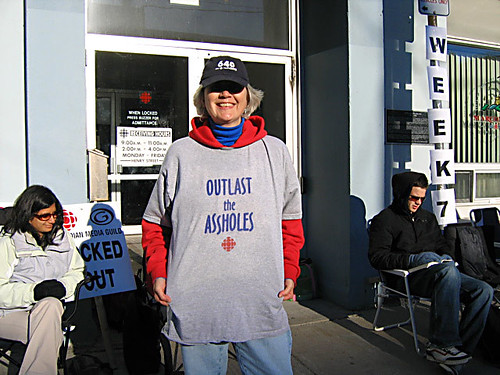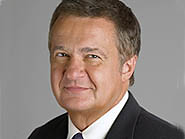 The final On the Go broadcast from the CBC Radio building on Duckworth Street was something of a letdown. I expected to hear more of the history of the building, drawing upon the wealth of archived material in the vault as well as memories of people who have hosted or contributed to the program in some way.
The final On the Go broadcast from the CBC Radio building on Duckworth Street was something of a letdown. I expected to hear more of the history of the building, drawing upon the wealth of archived material in the vault as well as memories of people who have hosted or contributed to the program in some way.There was at least one historical item (the show hasn’t been archived yet so I can’t confirm any others) and some coverage of contemporary issues. And host Ted Blades (right, CBC photo) did emphasize at one point that programming will continue and life will carry on at the new location. However, the program was dominated by ‘farewell’ material that had a melancholy, slightly bitter aftertaste.
The show opened with an indulgent, overdone segment in which Blades walked to work for the last time (as of Monday, he will have to drive to the CBC Building on Prince Philip Drive).
Blades’ point was that a walk down Duckworth Street – talking with people on the street, reading posters in shop windows and inhaling the rich harbour air – presents a bottomless well of story ideas that will be lost in the move to the parkway. Indeed, the downtown itself came across as a muse that percolates by osmosis through most of what is broadcast from the grand old building.
During the middle of the show, Blades spoke about the thousands of historically significant stories and interviews that originated at 342 Duckworth. The piece he played – a profile of a traveling butcher produced some years ago for Morningside – was good, but it was long; I would have preferred more of a montage that brought in different voices and issues.
The program concluded with Blades taking a meandering final walk through the building, his voice echoing in the empty hallways. It left the listener feeling sad and empty, which was no doubt Blades’ intent. But it didn’t work for me. There was too much bitter and not enough sweet.
The closure of the building reminds me of a person who has died at a ripe old age – we mourn their passing but ultimately celebrate their achievements.
That celebratory feel was missing from the show and I can understand why. Blades does not support the relocation across town and feels, as demonstrated by the opening piece, that something priceless will be lost in the move.
Blades' final walk to work was not great radio; I am sure it was edited down but it was nonetheless long and not terribly illuminating. I do respect what he was trying to accomplish. The item was seasoned with a dash of rebellion and a pinch of protest, something I applaud in all journalists. I share anyone’s apprehension about moving from an office to a cubicle environment, and wonder what management can do to address this. (With all the space in the TV building, do they really need to jam people into cubicles?) And I do agree that CBC Radio is part of the downtown character, and vice versa.
However, I think the contention that walking to work puts one ‘in touch’ with the heart of the city and generates new story ideas is exaggerated. A stroll downtown and a detour to Hava Java may net a story idea on occasion, but it should only account for a small percentage of program content, especially given On the Go’s province-wide audience.
There is absolutely no substitute for a well-established network of contacts within the various strata of society, including the arts, business, government and not-for-profit sectors.
In this respect, I feel that programming on all of the local radio shows will actually improve in the months ahead, as producers, hosts and reporters work the phones, email and Internet much more in the pursuit and development of new story ideas. They will also benefit from new perspectives gained through collaboration with their colleagues in television.
And downtown is not that far away. There is nothing stopping any of them from taking a dash downtown for lunch, coffee or even a walk up Duckworth Street.
I wish all the employees well in their new location, and will be checking back in the weeks ahead to see how they are feeling about the move.


























